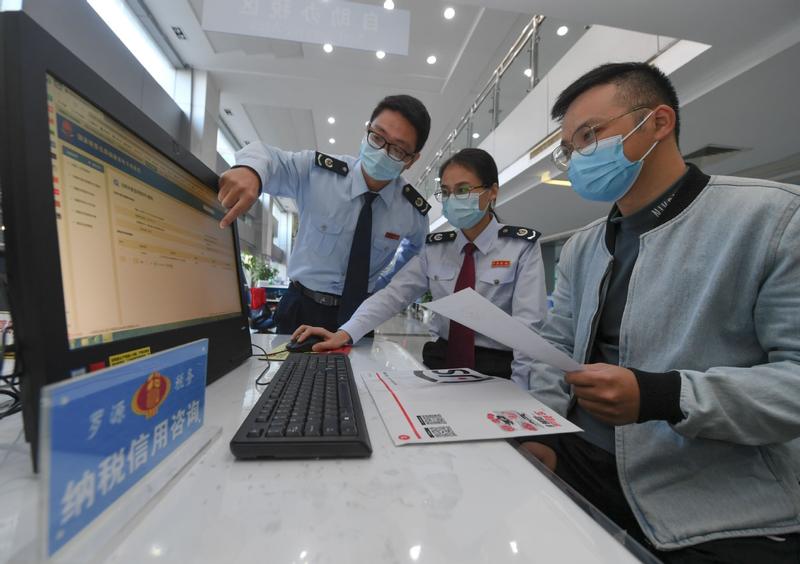 Officials help a taxpayer at an office in Fuzhou, Fujian province, on Nov 11. (PHOTO / XINHUA)
Officials help a taxpayer at an office in Fuzhou, Fujian province, on Nov 11. (PHOTO / XINHUA)
China achieved its budgeted tax income target for 2020 despite the COVID-19 effect on taxpayers and the slew of rebates, prompting policymakers to suggest a continuation of the measures to keep costs at bay and control risks for this year.
The government's total tax revenue stood at 13.68 trillion yuan (US$2.12 trillion) last year, the annual target set by the fiscal budget. It accounted for 15.2 percent of the country's GDP compared with 16.02 percent in 2019, the State Taxation Administration, the nation's tax authority, said on Wednesday.
The government's total tax revenue stood at 13.68 trillion yuan (US$2.12 trillion) last year, the annual target set by the fiscal budget. It accounted for 15.2 percent of the country's GDP compared with 16.02 percent in 2019, said the State Taxation Administration, the nation's tax authority
The lower tax income-to-GDP ratio is an indication that the overall tax burden has been further eased for companies, along with a substantial growth in sales revenue, said Cai Zili, a senior official from the STA.
Based on data gleaned from value-added tax invoices, the full-year sales revenue of Chinese enterprises rose by 6 percent on a yearly basis due to effective pandemic control measures and early work restarts.
However, on a yearly basis, total tax income declined by 2.6 percent in 2020, due to the shocks by COVID-19 pandemic and the government decision to cut taxes to hedge against economic and public health risks, said the STA official.
Based on official data, the share of tax payments by enterprises for every 100 yuan of business income has consistently dropped during the past five years. However, there has also been an "implicit burden" due to public risks, such as the sudden outbreak of COVID-19, which prompted tax authorities to focus more on the medium to long-term effects on firms, said Liu Shangxi, head of the Chinese Academy of Fiscal Sciences at the Ministry of Finance.
ALSO READ: Fiscal revenue rises by 4.7% in Q3
Tax policies need to be consistent so that they can help stabilize enterprises' expectations despite the uncertainties, Liu said at a seminar.
Authorities said that the total tax and fee cuts in 2020 could be around 2.5 trillion yuan, mainly through lower value-added tax rates and social security fees.
In 2020, the country's tax and fee reduction plan focused on helping market entities tide over the difficulties and promote economic recovery. The manufacturing industry and the private sector are expected to benefit the most from the plan, as indicated by the tax-to-sales revenue rates which decreased by 8.8 percent and 9.5 percent, respectively, according to the STA.
A survey conducted by Liu's research team showed that for most enterprises, tax payments accounted for less than 5 percent of the overall costs by 2020, while labor costs have been rising moderately.
The survey suggested an extension of the social security fee reduction plan that was launched last year, reduction of taxes on research and development spending, improved tax preference policies for companies providing public infrastructure and lowering the upper margin for personal income tax.
Liu Shijin, deputy director of the Economic Affairs Committee of the National Committee of the Chinese People's Political Consultative Conference, said since China has entered an era of high-quality economic development, higher standards are needed to achieve a reduction in enterprise costs. The costs of environment protection and carbon emissions control, for example, need to be included in a firm's cost calculation models, he said.
READ MORE: Officials: China unlikely to dilute fiscal stimulus package


